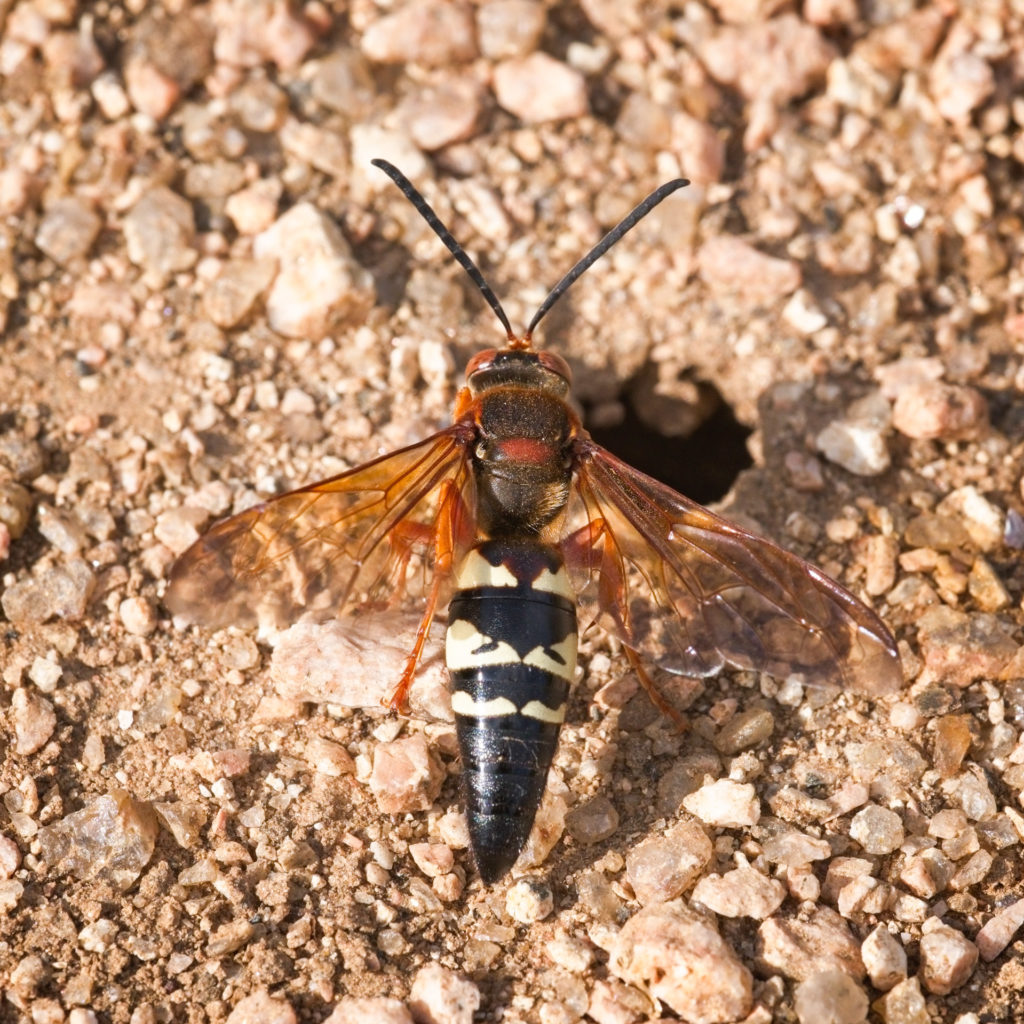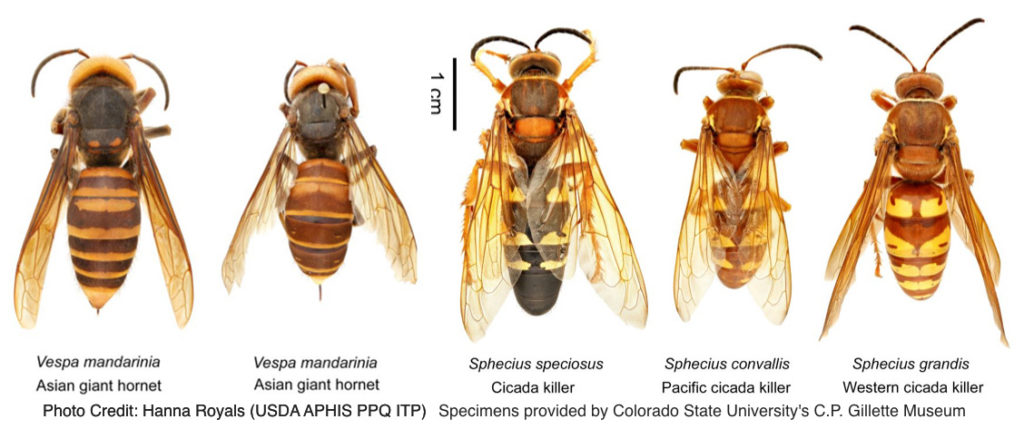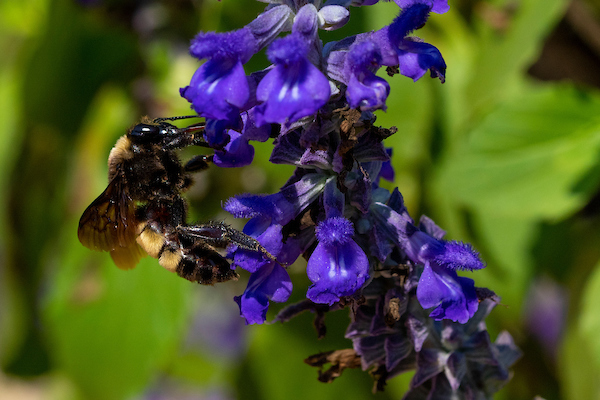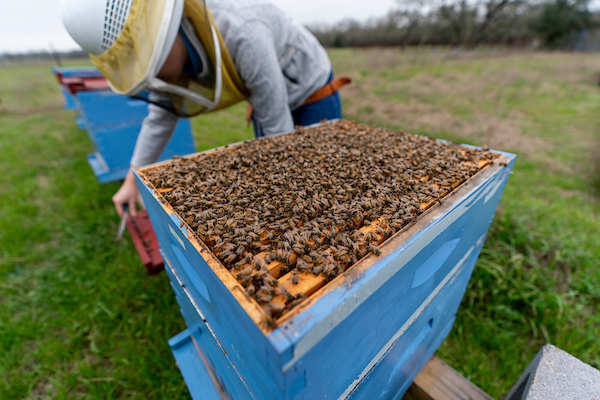It’s big, but it’s not a ‘murder hornet’
Texas A&M AgriLife experts say Texans mistakenly identifying cicada killer wasps
Each summer since the release of information about Northern giant hornets being found in Washington state in 2020, Texas A&M AgriLife entomologists have been inundated with questions and reported sightings.

But these sightings of Northern giant hornets, which were formerly named the Asian giant hornet and commonly called “murder hornet,” are nothing more than cases of mistaken identity, said Molly Keck, Texas A&M AgriLife Extension Service integrated pest management specialist and entomologist, San Antonio.
Keck and other AgriLife Extension entomologists said people are most likely mistaking cicada killers, which are large native Texas wasps, for Northern giant hornets.
“Northern giant hornets are not in Texas, and from reports, agencies in Washington state have done a very good job of controlling their numbers and preventing their spread,” she said. “It would be a far leap for them to be in Texas.” Keck said she is mostly receiving phone calls about sightings. But she also receives photos of native cicada killers, also known as ground hornets, submitted as suspected Northern giant hornets.
It’s a bird, it’s a plane … it’s a cicada killer
The Northern giant hornet was renamed by the Entomology Society of America and added to the group’s Common Names of Insects and Related Organisms List.

While state agencies want to encourage Texans to be vigilant in watching for the Northern giant hornet, also known as murder hornet, they also want to help provide guidance that will help narrow the focus.
Northern giant hornets are native to Japan and South Korea and have only been found in parts of British Columbia, Canada and the northwestern corner of Washington state.
When the Northern giant hornet was reported in Washington in May 2020, the concern was enough to prompt Gov. Greg Abbott to request a task force be mobilized to prepare Texas against the hornet’s arrival. But there have been no confirmed reports of these hornets outside of Whatcom County, Washington.
Robert Puckett, Ph.D., associate professor and AgriLife Extension entomologist in the Texas A&M Department of Entomology, Bryan-College Station, said the Washington Department of Agriculture is conducting a very effective program to contain the wasp’s spread and possibly eradicate it in the U.S.
Beekeepers and other volunteers set live traps to capture Northern giant hornets. Trapped hornets are then tagged with a tracking device and released to return to the nest. The nest is then targeted for eradication.
“Usually, when I hear about an invasive species, I say ‘welp, it’s here. Game over,’” he said. “But this method is working to at least control them, and I wouldn’t be surprised if they eradicate them completely.”
Summer, cicadas and cicada killers
Summer months are the normal time for the cicada killer wasp, a common large wasp in Texas, to be seen. They typically start showing up in June as their offspring’s main food source – cicadas – emerge.
Cicada killer sightings continue to prompt phone calls, emails and posts on social media and in news feeds with mistaken identifications.
“I don’t know that cicada killers are in higher numbers this year, but people are noticing them and swear they are seeing an Asian giant hornet,” Keck said. “It looks like this could happen every summer, especially when cicada killer numbers are peaking.”
Pat Porter, Ph.D., AgriLife Extension entomologist in Lubbock, developed a short video explaining the differences between the “murder hornet” and several common lookalikes here in Texas.
“To date, we have identified hundreds of insects that people in Texas suspect might be Northern giant hornets (murder hornets),” Porter said. “Eighty percent of these have been either the eastern cicada killer or western cicada killer. But it is understandable how non-entomologists might think they saw a Northern giant hornet.”
How to tell the difference
There are a number of Texas native species of wasps, hornets, yellow jackets and bees, but what really separates Northern giant hornets and a few of our native species is their size. The flying insects most likely to be confused with Northern giant hornet are the native species of cicada killers and the pigeon horntail.
The Northern giant hornet is the world’s largest known hornet measuring 1.5-2 inches in length. It has a head as wide as its shoulders, where the wings and legs are located, or wider, and it is a bright orange or yellow. The thorax, or shoulder portion where the wings and legs are connected, is a dark brown, as are the antenna. It has a much smaller or pinched waist and then smooth looking brown and orange stripes cover the abdomen.
The cicada killer, of which there are three different species in Texas, are also quite large, measuring 1-1.5 inches in length. But they all typically have a head that is narrower than the thorax. The head and the thorax are typically the same color, a darker orange or brown color. It does also have a pinched waist. But the stripes on the abdomen are irregular and will be jagged and sometimes look like mountains.
The eastern cicada killer tends to be black and yellow. The western cicada killer is closer in color to the Asian giant hornet, being reddish brown and yellow. But there is no contrasting color between the head and thorax and the stripes are jagged on the western cicada killer.
Puckett said the easiest way to identify a cicada killer wasp is the irregular markings on the abdomen.
“I always ask people to look at the coloration and whether they see consistent, distinct stripes across the abdomen or a kind of lumpy, irregular marking on the abdomen,” he said. “That irregular pattern is the dead giveaway that it is a cicada killer.”
The other group of insects most commonly confused with the Northern giant hornet are the horntail or wood wasps. They are large, have a distinct head that is as wide or wider than the thorax, and may share the same coloration as the Northern giant hornet. However, there is one trait that is easy to spot that is different, and that is the fact that horntails lack any appearance of a waist.
Not harmful, just alarming
The Northern giant hornet preys on bees and can decimate local honeybee populations, essential for most fruit and vegetable crop production. The Asian giant hornets also are fiercely protective of their nests and will deploy painful stings that can cause fatal allergic reactions in people already sensitive to bee stings.
The cicada killer and wood wasps, however, are solitary and thus do not aggressively protect their nesting sites by attacking in large numbers, Keck said. Cicada killers, however, may cause alarm due to the males’ territorial behavior, dive-bombing or buzzing people and animals that walk into their territory.
Although cicada killers are solitary, numerous individuals can often be found in areas with sandy soils where females dig nests in the ground, she said. Nests appear as dime to quarter sized holes in the ground. Females come and go, provisioning their nest with cicadas they paralyze with a sting and carry back to their nests.
Males are more interested in mating, she said. Males are territorial and may try to chase off intruders they perceive as a threat to their mating opportunities. But male wasps are not capable of stinging and are not dangerous.
“Cicada killers can be a nuisance for a few weeks out of the year during the nesting season, but they are not a threat to us,” Keck said. “Females can sting but are very docile, and reports of stings are rare.”
Horntails and wood wasps may have what appear to be very long stingers, but they are unable to sting. They lack venom glands and instead they use this structure, called an ovipositor, to insert eggs into plant tissue, hence the name wood wasp, Keck said.
“We just want people to be aware that what they are seeing are not the Northern giant hornet,” she said. “But we also don’t want people to be concerned and needlessly killing cicada killers.”






